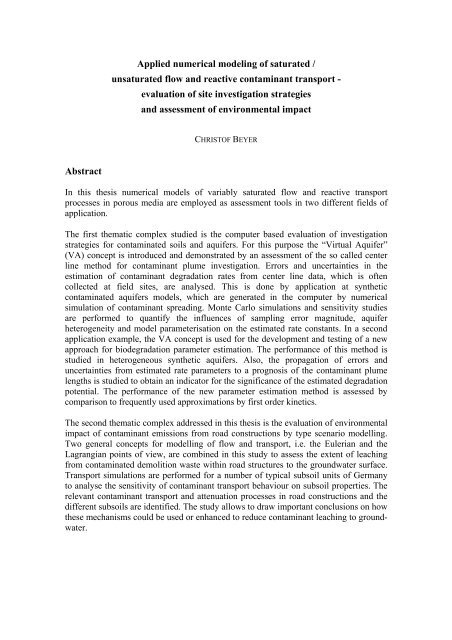Applied numerical modeling of saturated / unsaturated flow and ...
Applied numerical modeling of saturated / unsaturated flow and ...
Applied numerical modeling of saturated / unsaturated flow and ...
You also want an ePaper? Increase the reach of your titles
YUMPU automatically turns print PDFs into web optimized ePapers that Google loves.
Abstract<br />
<strong>Applied</strong> <strong>numerical</strong> <strong>modeling</strong> <strong>of</strong> <strong>saturated</strong> /<br />
un<strong>saturated</strong> <strong>flow</strong> <strong>and</strong> reactive contaminant transport -<br />
evaluation <strong>of</strong> site investigation strategies<br />
<strong>and</strong> assessment <strong>of</strong> environmental impact<br />
CHRISTOF BEYER<br />
In this thesis <strong>numerical</strong> models <strong>of</strong> variably <strong>saturated</strong> <strong>flow</strong> <strong>and</strong> reactive transport<br />
processes in porous media are employed as assessment tools in two different fields <strong>of</strong><br />
application.<br />
The first thematic complex studied is the computer based evaluation <strong>of</strong> investigation<br />
strategies for contaminated soils <strong>and</strong> aquifers. For this purpose the “Virtual Aquifer”<br />
(VA) concept is introduced <strong>and</strong> demonstrated by an assessment <strong>of</strong> the so called center<br />
line method for contaminant plume investigation. Errors <strong>and</strong> uncertainties in the<br />
estimation <strong>of</strong> contaminant degradation rates from center line data, which is <strong>of</strong>ten<br />
collected at field sites, are analysed. This is done by application at synthetic<br />
contaminated aquifers models, which are generated in the computer by <strong>numerical</strong><br />
simulation <strong>of</strong> contaminant spreading. Monte Carlo simulations <strong>and</strong> sensitivity studies<br />
are performed to quantify the influences <strong>of</strong> sampling error magnitude, aquifer<br />
heterogeneity <strong>and</strong> model parameterisation on the estimated rate constants. In a second<br />
application example, the VA concept is used for the development <strong>and</strong> testing <strong>of</strong> a new<br />
approach for biodegradation parameter estimation. The performance <strong>of</strong> this method is<br />
studied in heterogeneous synthetic aquifers. Also, the propagation <strong>of</strong> errors <strong>and</strong><br />
uncertainties from estimated rate parameters to a prognosis <strong>of</strong> the contaminant plume<br />
lengths is studied to obtain an indicator for the significance <strong>of</strong> the estimated degradation<br />
potential. The performance <strong>of</strong> the new parameter estimation method is assessed by<br />
comparison to frequently used approximations by first order kinetics.<br />
The second thematic complex addressed in this thesis is the evaluation <strong>of</strong> environmental<br />
impact <strong>of</strong> contaminant emissions from road constructions by type scenario modelling.<br />
Two general concepts for modelling <strong>of</strong> <strong>flow</strong> <strong>and</strong> transport, i.e. the Eulerian <strong>and</strong> the<br />
Lagrangian points <strong>of</strong> view, are combined in this study to assess the extent <strong>of</strong> leaching<br />
from contaminated demolition waste within road structures to the groundwater surface.<br />
Transport simulations are performed for a number <strong>of</strong> typical subsoil units <strong>of</strong> Germany<br />
to analyse the sensitivity <strong>of</strong> contaminant transport behaviour on subsoil properties. The<br />
relevant contaminant transport <strong>and</strong> attenuation processes in road constructions <strong>and</strong> the<br />
different subsoils are identified. The study allows to draw important conclusions on how<br />
these mechanisms could be used or enhanced to reduce contaminant leaching to groundwater.<br />
3

















